Gabriel Loaiza-Ganem
On Convolutions, Intrinsic Dimension, and Diffusion Models
Jun 25, 2025Abstract:The manifold hypothesis asserts that data of interest in high-dimensional ambient spaces, such as image data, lies on unknown low-dimensional submanifolds. Diffusion models (DMs) -- which operate by convolving data with progressively larger amounts of Gaussian noise and then learning to revert this process -- have risen to prominence as the most performant generative models, and are known to be able to learn distributions with low-dimensional support. For a given datum in one of these submanifolds, we should thus intuitively expect DMs to have implicitly learned its corresponding local intrinsic dimension (LID), i.e. the dimension of the submanifold it belongs to. Kamkari et al. (2024b) recently showed that this is indeed the case by linking this LID to the rate of change of the log marginal densities of the DM with respect to the amount of added noise, resulting in an LID estimator known as FLIPD. LID estimators such as FLIPD have a plethora of uses, among others they quantify the complexity of a given datum, and can be used to detect outliers, adversarial examples and AI-generated text. FLIPD achieves state-of-the-art performance at LID estimation, yet its theoretical underpinnings are incomplete since Kamkari et al. (2024b) only proved its correctness under the highly unrealistic assumption of affine submanifolds. In this work we bridge this gap by formally proving the correctness of FLIPD under realistic assumptions. Additionally, we show that an analogous result holds when Gaussian convolutions are replaced with uniform ones, and discuss the relevance of this result.
Textual Bayes: Quantifying Uncertainty in LLM-Based Systems
Jun 11, 2025
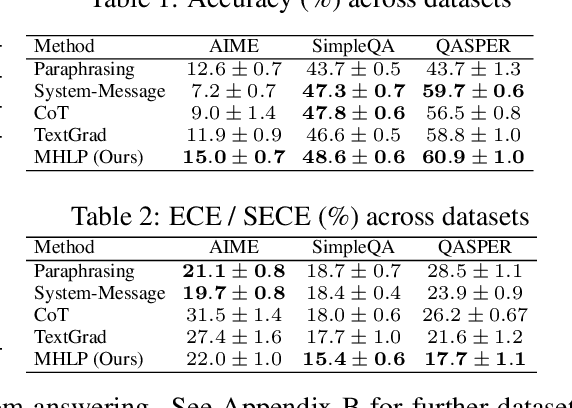
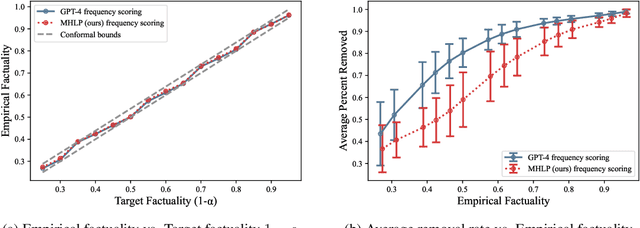
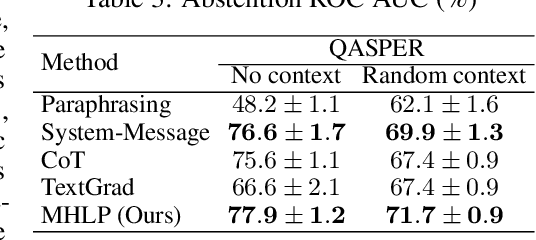
Abstract:Although large language models (LLMs) are becoming increasingly capable of solving challenging real-world tasks, accurately quantifying their uncertainty remains a critical open problem, which limits their applicability in high-stakes domains. This challenge is further compounded by the closed-source, black-box nature of many state-of-the-art LLMs. Moreover, LLM-based systems can be highly sensitive to the prompts that bind them together, which often require significant manual tuning (i.e., prompt engineering). In this work, we address these challenges by viewing LLM-based systems through a Bayesian lens. We interpret prompts as textual parameters in a statistical model, allowing us to use a small training dataset to perform Bayesian inference over these prompts. This novel perspective enables principled uncertainty quantification over both the model's textual parameters and its downstream predictions, while also incorporating prior beliefs about these parameters expressed in free-form text. To perform Bayesian inference, a difficult problem even for well-studied data modalities, we introduce Metropolis-Hastings through LLM Proposals (MHLP), a novel Markov chain Monte Carlo (MCMC) algorithm that combines prompt optimization techniques with standard MCMC methods. MHLP is a turnkey modification to existing LLM pipelines, including those that rely exclusively on closed-source models. Empirically, we demonstrate that our method yields improvements in both predictive accuracy and uncertainty quantification (UQ) on a range of LLM benchmarks and UQ tasks. More broadly, our work demonstrates a viable path for incorporating methods from the rich Bayesian literature into the era of LLMs, paving the way for more reliable and calibrated LLM-based systems.
Last Layer Empirical Bayes
May 21, 2025Abstract:The task of quantifying the inherent uncertainty associated with neural network predictions is a key challenge in artificial intelligence. Bayesian neural networks (BNNs) and deep ensembles are among the most prominent approaches to tackle this task. Both approaches produce predictions by computing an expectation of neural network outputs over some distribution on the corresponding weights; this distribution is given by the posterior in the case of BNNs, and by a mixture of point masses for ensembles. Inspired by recent work showing that the distribution used by ensembles can be understood as a posterior corresponding to a learned data-dependent prior, we propose last layer empirical Bayes (LLEB). LLEB instantiates a learnable prior as a normalizing flow, which is then trained to maximize the evidence lower bound; to retain tractability we use the flow only on the last layer. We show why LLEB is well motivated, and how it interpolates between standard BNNs and ensembles in terms of the strength of the prior that they use. LLEB performs on par with existing approaches, highlighting that empirical Bayes is a promising direction for future research in uncertainty quantification.
Deep Ensembles Secretly Perform Empirical Bayes
Jan 29, 2025Abstract:Quantifying uncertainty in neural networks is a highly relevant problem which is essential to many applications. The two predominant paradigms to tackle this task are Bayesian neural networks (BNNs) and deep ensembles. Despite some similarities between these two approaches, they are typically surmised to lack a formal connection and are thus understood as fundamentally different. BNNs are often touted as more principled due to their reliance on the Bayesian paradigm, whereas ensembles are perceived as more ad-hoc; yet, deep ensembles tend to empirically outperform BNNs, with no satisfying explanation as to why this is the case. In this work we bridge this gap by showing that deep ensembles perform exact Bayesian averaging with a posterior obtained with an implicitly learned data-dependent prior. In other words deep ensembles are Bayesian, or more specifically, they implement an empirical Bayes procedure wherein the prior is learned from the data. This perspective offers two main benefits: (i) it theoretically justifies deep ensembles and thus provides an explanation for their strong empirical performance; and (ii) inspection of the learned prior reveals it is given by a mixture of point masses -- the use of such a strong prior helps elucidate observed phenomena about ensembles. Overall, our work delivers a newfound understanding of deep ensembles which is not only of interest in it of itself, but which is also likely to generate future insights that drive empirical improvements for these models.
Inconsistencies In Consistency Models: Better ODE Solving Does Not Imply Better Samples
Nov 13, 2024



Abstract:Although diffusion models can generate remarkably high-quality samples, they are intrinsically bottlenecked by their expensive iterative sampling procedure. Consistency models (CMs) have recently emerged as a promising diffusion model distillation method, reducing the cost of sampling by generating high-fidelity samples in just a few iterations. Consistency model distillation aims to solve the probability flow ordinary differential equation (ODE) defined by an existing diffusion model. CMs are not directly trained to minimize error against an ODE solver, rather they use a more computationally tractable objective. As a way to study how effectively CMs solve the probability flow ODE, and the effect that any induced error has on the quality of generated samples, we introduce Direct CMs, which \textit{directly} minimize this error. Intriguingly, we find that Direct CMs reduce the ODE solving error compared to CMs but also result in significantly worse sample quality, calling into question why exactly CMs work well in the first place. Full code is available at: https://github.com/layer6ai-labs/direct-cms.
A Geometric Framework for Understanding Memorization in Generative Models
Oct 31, 2024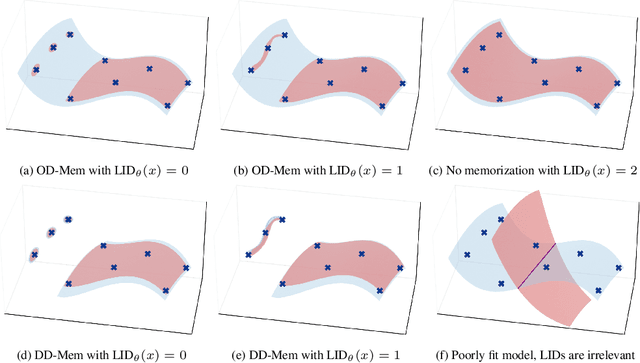

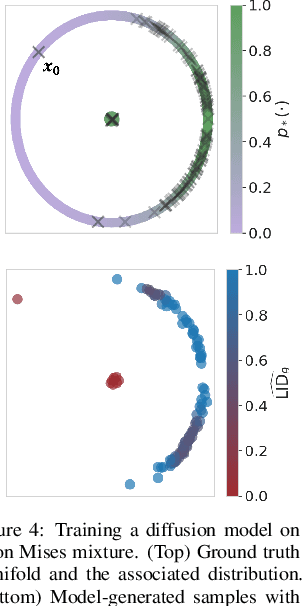
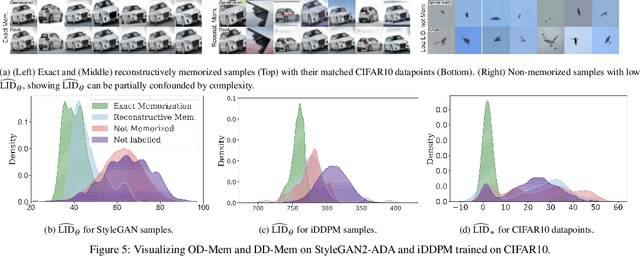
Abstract:As deep generative models have progressed, recent work has shown them to be capable of memorizing and reproducing training datapoints when deployed. These findings call into question the usability of generative models, especially in light of the legal and privacy risks brought about by memorization. To better understand this phenomenon, we propose the manifold memorization hypothesis (MMH), a geometric framework which leverages the manifold hypothesis into a clear language in which to reason about memorization. We propose to analyze memorization in terms of the relationship between the dimensionalities of $(i)$ the ground truth data manifold and $(ii)$ the manifold learned by the model. This framework provides a formal standard for "how memorized" a datapoint is and systematically categorizes memorized data into two types: memorization driven by overfitting and memorization driven by the underlying data distribution. By analyzing prior work in the context of the MMH, we explain and unify assorted observations in the literature. We empirically validate the MMH using synthetic data and image datasets up to the scale of Stable Diffusion, developing new tools for detecting and preventing generation of memorized samples in the process.
CaloChallenge 2022: A Community Challenge for Fast Calorimeter Simulation
Oct 28, 2024
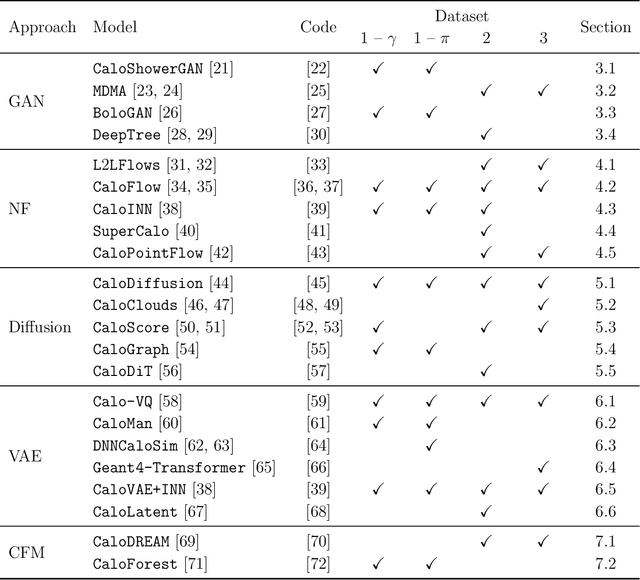
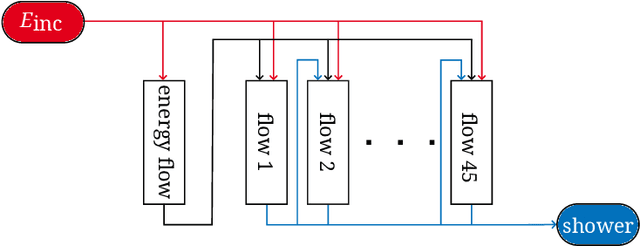
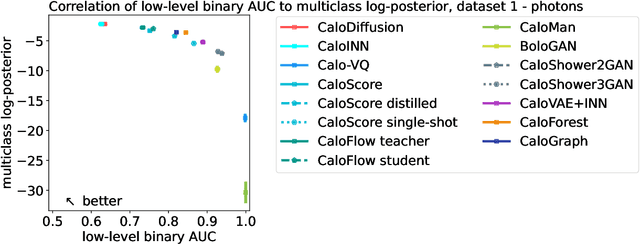
Abstract:We present the results of the "Fast Calorimeter Simulation Challenge 2022" - the CaloChallenge. We study state-of-the-art generative models on four calorimeter shower datasets of increasing dimensionality, ranging from a few hundred voxels to a few tens of thousand voxels. The 31 individual submissions span a wide range of current popular generative architectures, including Variational AutoEncoders (VAEs), Generative Adversarial Networks (GANs), Normalizing Flows, Diffusion models, and models based on Conditional Flow Matching. We compare all submissions in terms of quality of generated calorimeter showers, as well as shower generation time and model size. To assess the quality we use a broad range of different metrics including differences in 1-dimensional histograms of observables, KPD/FPD scores, AUCs of binary classifiers, and the log-posterior of a multiclass classifier. The results of the CaloChallenge provide the most complete and comprehensive survey of cutting-edge approaches to calorimeter fast simulation to date. In addition, our work provides a uniquely detailed perspective on the important problem of how to evaluate generative models. As such, the results presented here should be applicable for other domains that use generative AI and require fast and faithful generation of samples in a large phase space.
A Geometric View of Data Complexity: Efficient Local Intrinsic Dimension Estimation with Diffusion Models
Jun 05, 2024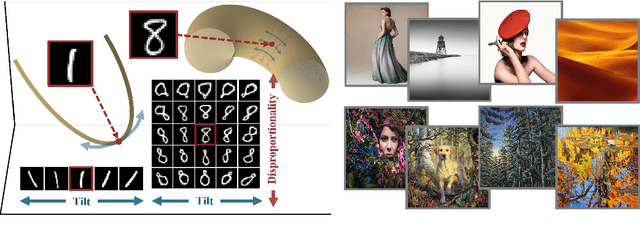

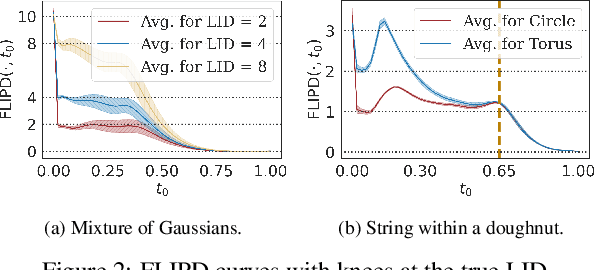

Abstract:High-dimensional data commonly lies on low-dimensional submanifolds, and estimating the local intrinsic dimension (LID) of a datum -- i.e. the dimension of the submanifold it belongs to -- is a longstanding problem. LID can be understood as the number of local factors of variation: the more factors of variation a datum has, the more complex it tends to be. Estimating this quantity has proven useful in contexts ranging from generalization in neural networks to detection of out-of-distribution data, adversarial examples, and AI-generated text. The recent successes of deep generative models present an opportunity to leverage them for LID estimation, but current methods based on generative models produce inaccurate estimates, require more than a single pre-trained model, are computationally intensive, or do not exploit the best available deep generative models, i.e. diffusion models (DMs). In this work, we show that the Fokker-Planck equation associated with a DM can provide a LID estimator which addresses all the aforementioned deficiencies. Our estimator, called FLIPD, is compatible with all popular DMs, and outperforms existing baselines on LID estimation benchmarks. We also apply FLIPD on natural images where the true LID is unknown. Compared to competing estimators, FLIPD exhibits a higher correlation with non-LID measures of complexity, better matches a qualitative assessment of complexity, and is the only estimator to remain tractable with high-resolution images at the scale of Stable Diffusion.
Deep Generative Models through the Lens of the Manifold Hypothesis: A Survey and New Connections
Apr 03, 2024


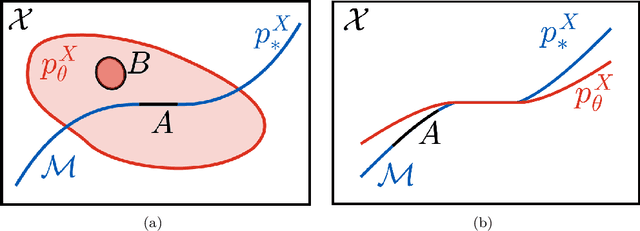
Abstract:In recent years there has been increased interest in understanding the interplay between deep generative models (DGMs) and the manifold hypothesis. Research in this area focuses on understanding the reasons why commonly-used DGMs succeed or fail at learning distributions supported on unknown low-dimensional manifolds, as well as developing new models explicitly designed to account for manifold-supported data. This manifold lens provides both clarity as to why some DGMs (e.g. diffusion models and some generative adversarial networks) empirically surpass others (e.g. likelihood-based models such as variational autoencoders, normalizing flows, or energy-based models) at sample generation, and guidance for devising more performant DGMs. We carry out the first survey of DGMs viewed through this lens, making two novel contributions along the way. First, we formally establish that numerical instability of high-dimensional likelihoods is unavoidable when modelling low-dimensional data. We then show that DGMs on learned representations of autoencoders can be interpreted as approximately minimizing Wasserstein distance: this result, which applies to latent diffusion models, helps justify their outstanding empirical results. The manifold lens provides a rich perspective from which to understand DGMs, which we aim to make more accessible and widespread.
A Geometric Explanation of the Likelihood OOD Detection Paradox
Mar 27, 2024



Abstract:Likelihood-based deep generative models (DGMs) commonly exhibit a puzzling behaviour: when trained on a relatively complex dataset, they assign higher likelihood values to out-of-distribution (OOD) data from simpler sources. Adding to the mystery, OOD samples are never generated by these DGMs despite having higher likelihoods. This two-pronged paradox has yet to be conclusively explained, making likelihood-based OOD detection unreliable. Our primary observation is that high-likelihood regions will not be generated if they contain minimal probability mass. We demonstrate how this seeming contradiction of large densities yet low probability mass can occur around data confined to low-dimensional manifolds. We also show that this scenario can be identified through local intrinsic dimension (LID) estimation, and propose a method for OOD detection which pairs the likelihoods and LID estimates obtained from a pre-trained DGM. Our method can be applied to normalizing flows and score-based diffusion models, and obtains results which match or surpass state-of-the-art OOD detection benchmarks using the same DGM backbones. Our code is available at https://github.com/layer6ai-labs/dgm_ood_detection.
 Add to Chrome
Add to Chrome Add to Firefox
Add to Firefox Add to Edge
Add to Edge